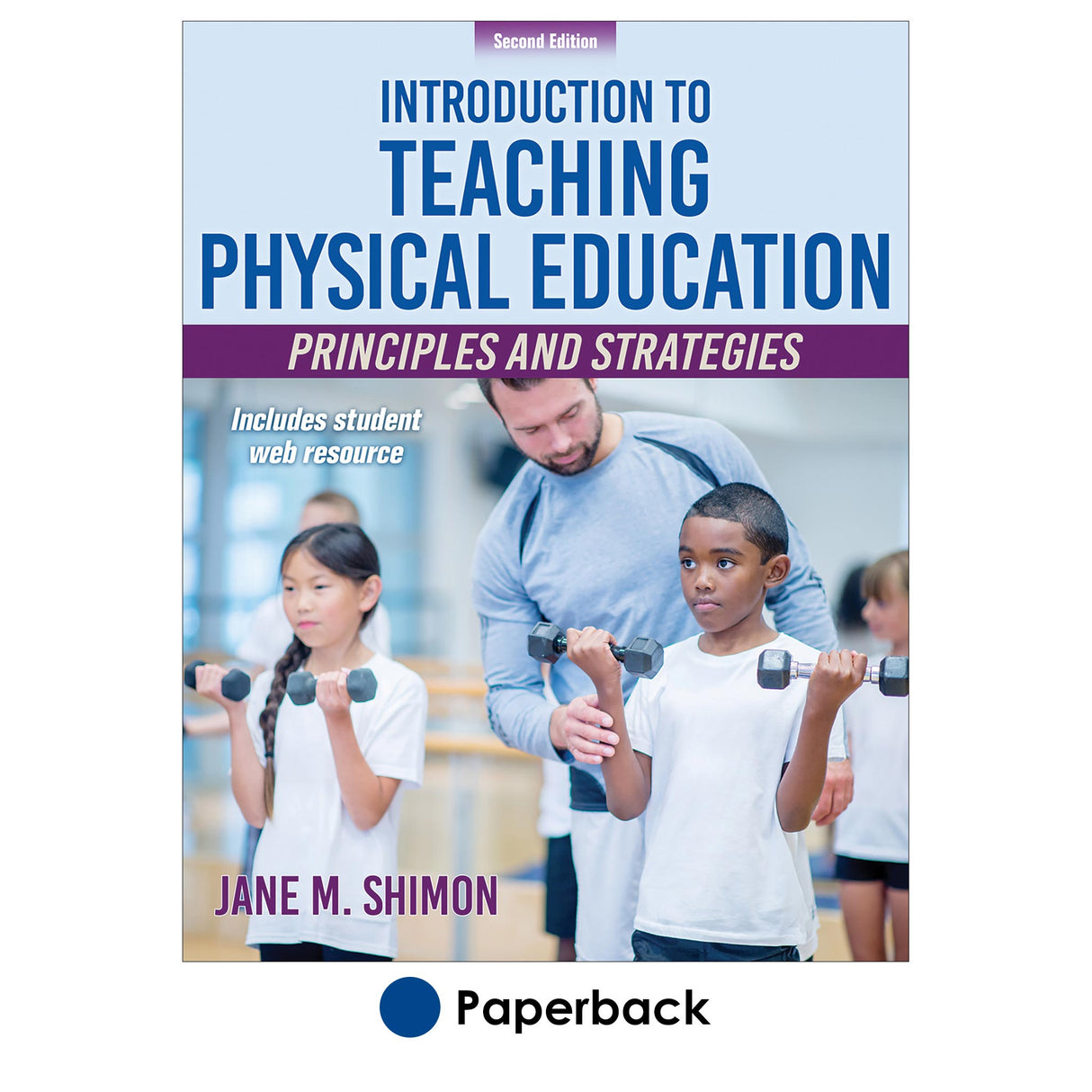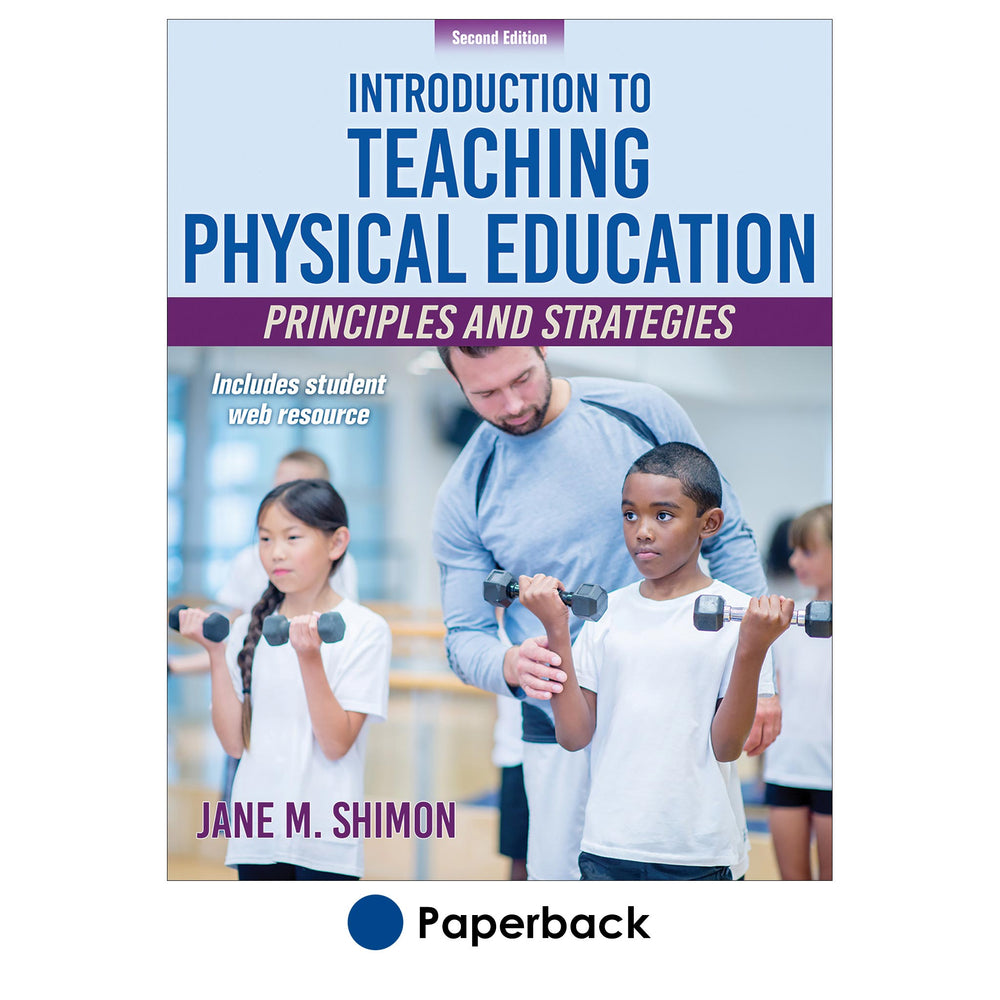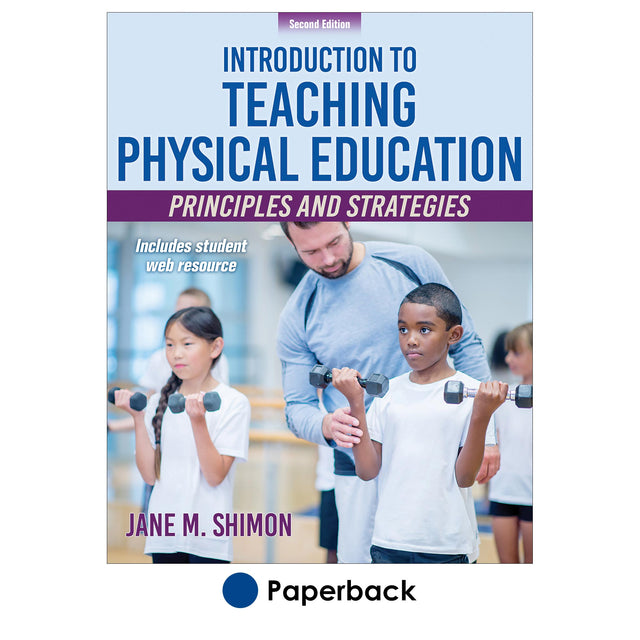Introduction to Teaching Physical Education 2nd Edition With Web Resource
Principles and Strategies
Author: Jane M. Shimon
$59.00 CAD
Three strengths that set the second edition of this book apart from its competitors are its sole focus on physical education, the depth and breadth of physical education topics it covers, and its affordability. It features the essential content that students need to build a strong base of instructional skills and an understanding of the field—and it does so in an engaging manner to get students excited about teaching physical education.
Introduction to Teaching Physical Education, Second Edition, delves into the theoretical, practical, and inspirational aspects of teaching physical education. Students can explore the field’s history, purpose, and concepts as well as learn teaching skills, examine instructional scope and sequence, and learn about the responsibilities of a teacher. They’ll also learn about teaching duties, motivation and behavior management strategies, assessment, lesson planning, technology and online resources, and careers in the field.
Updates and New Material
Introduction to Teaching Physical Education is updated to reflect the significant changes that have occurred in the field over the past few years, including SHAPE America’s National Standards and Grade-Level Outcomes for K–12 Physical Education, the SHAPE America Physical Education Teacher Education (PETE) guidelines, and more.
To keep up with the changes in the field, author Jane Shimon has revised or added new material:
- New Teachers Talking Teaching tips from national and district Teachers of the Year from around the country
- A new section addressing attentional focus and teaching cues
- New content on student engagement, differentiated instruction, and inclusion
- New material on technology, particularly regarding the use of mobile devices in physical education
- Extended information on writing lesson objectives and on the use of formative assessments
Book Organization
Introduction to Teaching Physical Education is organized into four parts. Part I outlines the history of physical education, including the two main systems that served as the profession’s foundation; influential concepts and people; and current advancements. It also discusses the purpose of physical education and highlights the many teaching and nonteaching duties of physical educators. Part II presents the details for teaching physical education, including the steps to organizing and instructing in the classroom and the gymnasium. It also looks at motivational theories and how to prevent misbehavior and positively manage student behavior.
In part III, students learn about planning lessons and assessing outcomes. They examine scope and sequence, learn how to develop appropriate objectives and quality lesson plans, and explore assessment and rubric design. Part IV affords students insight into current technology issues that can be used to enhance physical education, and it explores the career options available.
Ancillaries
Introduction to Teaching Physical Education offers several ancillary materials:
- A web resource featuring chapter overviews, definitions of key terms, and supplemental materials such as worksheets, lesson plan templates, and short situational studies
- An instructor guide with a sample course syllabus, chapter overviews, key terms, discussion questions, learning activities, and more
- A test package with more than 200 true-or-false and multiple-choice questions
- A PowerPoint presentation package with more than 200 slides, including select illustrations and tables
Introduction to Teaching Physical Education, Second Edition, will help students gain the knowledge and skills they need as they pursue their entry into the teaching profession, providing them with a springboard to advance in their coursework. This complete but concise text supplies the perfect introduction to the physical education field, covering the essentials in an engaging and informative way as students learn to apply the principles of teaching physical education.
Audience
Text for undergraduate PETE students and those considering majoring or minoring in physical education.Chapter 1. History of Physical Education
The Beginning
Physical Education in the United States
Early American Period: Mid-1700s to 1900
Early 20th Century: 1900 to 1930
Mid-20th Century: 1930 to 1970
Late 20th Century: 1970 to 2000
Early 21st Century: 2000 to Present
Summary
Chapter 2. Purpose, Benefits, and Philosophy
Purpose of Physical Education
National Physical Education Standards
Benefits of Physical Education
Philosophy of Physical Education
Summary
Chapter 3. Duties and Challenges
Teaching Duties and Roles
Nonteaching Duties
Issues and Concerns
Summary
Part II. Teaching Physical Education
Chapter 4. Organization and Instruction
Noninstructional Tasks: Classroom Organization
Instructional Tasks
Content Progressions and Practice Strategies
Teaching Styles
Summary
Chapter 5. Motivation
Motivational Theories
Strategies to Enhance Motivation
Summary
Chapter 6. Behavior Management
Behavior Management Safeguards
Behavior Management Strategies
Summary
Part III. Lesson Planning and Outcomes
Chapter 7. Scope and Sequence
Scope: Pre-Kindergarten (Pre-K)
Scope: Elementary School
Scope: Middle School and Junior High School
Scope: High School
Sequence
Summary
Chapter 8. Lesson Planning
Writing Performance Objectives for a Lesson Plan
Creating Lesson Plans
Supporting Individual Differences
Summary
Chapter 9. Student Assessment
Terminology
Assessment Options
Types of Rubrics
Rubric Construction
Grading Considerations
Health-Related Fitness Testing
Constructing Written Tests
Summary
Part IV. Beyond the Classroom
Chapter 10. Technology and Resources
Instructional Technology
Online Resources
Summary
Chapter 11. Careers in Physical Education
Alternative School Settings
Other Career Avenues
Summary
Appendix A. Appropriate Practice Guidelines and Instructional Strategies
Appendix B. Example of Class Policies and Expectations
Appendix C. Exercises for a Dynamic Warm-Up
Instructor guide. Includes a sample course syllabus, chapter overviews, key terms, discussion questions, and more.
Test package. Contains a bank of more than 200 questions in true-or-false and multiple-choice formats.
Presentation package. Features PowerPoint slide presentations for each chapter.
Web resource. Features chapter overviews, definitions of key terms, and supplemental materials such as worksheets, lesson plan templates, and short situational studies.
Human Kinetics is pleased to partner with SHAPE America by offering discounts on our resources to SHAPE America members! Whether you’re a preK-12 teacher, higher education faculty member, researcher, administrator, or future professional, we’re here to help you in your professional career and personal fitness journey of improved fitness, stronger athletic performance, and better nutrition.
SHAPE America members receive a 30% discount on this resource and other eligible resources through the member portal at SHAPE America. Learn more about SHAPE America membership at SHAPEAmerica.org or direct your questions about the discount to askmembership@shapeamerica.org.





